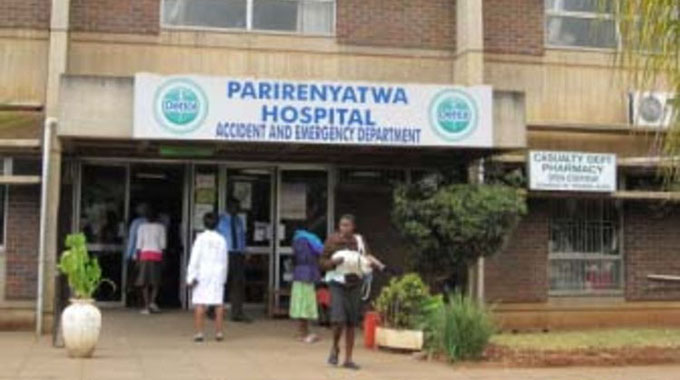Maternal mortality rate still high in Zimbabwe

Rumbidzai Ngwenya Features Writer
Christine died at the age of 34 while giving birth to her fourth child at Parirenyatwa Group of Hospitals in Harare. She had had complications during her pregnancy but never sought medical attention.
During her pregnancy she was staying in Buhera at her rural home. She started bleeding in her first trimester and as the pregnancy progressed, more complications developed. She complained of severe headaches, abdominal and chest pains.
Like most women in the rural areas, she booked for antenatal care in her third trimester at a local clinic. She never went back for check-up hence no problem was detected.
Although she was in pain, she continued to do all the household chores, taking care of her children and in-laws. No family member took her complains serious, after all pregnant women experience morning sickness.
When the pregnancy was due the pain worsened and her hands and feet started swelling. She was rushed to the clinic where they referred her to Murambinda Hospital as the clinic was not well equipped to deal with her situation.
At Murambinda, they also had to refer her to Parirenyatwa Hospital as they said there were complications with her pregnancy and with limited resources could not perform a caesarean section.
Upon arrival, that same day, at Parirenyatwa she went through an emergency caesarean section. Unfortunately, the baby was stillborn. After the operation she was rushed to the Intensive Care Unit as her condition deteriorated. It was said she had suffered from placental abruption, a serious condition in which the placenta partially or completely separates from the uterus before the baby is born.
From the look of things the baby had died a while back without her realising. It had affected her uterus and other vital organs were shutting down. There was nothing the doctors could do at that time to save her. Within 24 hours, she also died.
This is just one of many cases of maternal mortality in Zimbabwe. Maternal mortality is defined as death of a woman while pregnant or within 42 days of termination of pregnancy.
According to the United Nations Population Fund (UNFPA), although Maternal Mortality Ratio (MMR) for Zimbabwe has declined from 960 deaths per 100,000 live births in 2010 to 614 deaths per 100,000 live births in 2014, it is still unacceptably high.
During a media workshop and field tour held recently in Mutare, UNFPA health specialist Dr Edwin Mpeta reviewed that social injustices were leading causes to maternal mortality.
“Maternal mortality continue to exist because of social injustices such as poverty, costs, distances to clinics where expectant mothers are supposed to receive antenatal care, lack of support from families and lack of information among pregnant women,” he said.
Stakeholders in the health sector including the Zimbabwe National Family Planning Council (ZNFPC) called for the Government to increase budget allocation to the health sector to help reduce maternal mortality through the provision of quality antennal care even in rural areas.
UNFPA said a budgetary increase will ensure that barriers women face during pregnancy are eliminated.
“As much there are free services for pregnant women such as free booking, they are required to pay for things like scanning. The impact of free services cannot be seen as most women cannot afford services they are required to pay for,” Dr Mpeta said.
“There is also not enough equipment and drugs in most hospitals and clinics that rural women have to be transferred to far away bigger hospitals if complications occur.
“These are some of the issues that need to be addressed and only if the budget allocation is increased to the health sector.”
Nyanga District Hospital matron, Dorothy Toma urged pregnant women across the country to seek antenatal care in their first trimester to enable early detection of complications.
If Christine had visited the clinic earlier and regularly, maybe her life and that of her baby could have been saved.
“Most women in rural areas have a tendency of going to the clinic for bookings in their last trimester for reasons such as long distances to the clinic. We have seen that at this hospital too,” said Toma.
“This is not advisable and we continue to urge women to seek antenatal care in the early stages of pregnancy so that complications can be detected.”
Toma also advised families to offer support to pregnant women and ensure they have best care during pregnancy to reduce deaths.
“Because it is known that pregnant women experience morning sickness, family members usually ignore when pregnant women complain of pain. With that most complications are detected late.
“Families should ensure that pregnant mothers have antenatal care and offer them support regardless of the number of children a women may have or her age,” she said.
Women continue to die from causes related to or aggravated by pregnancy or its management every day.
Every two minutes across the world a woman dies from potentially avoidable or preventable problems in pregnancies or childbirth. That is 800 mothers a day, 300 000 a year.
According to World Health Organisation (WHO), the primary causes of death in pregnant women are haemorrhage, hypertension, infections, and indirect causes, mostly due to interaction between pre-existing medical conditions and pregnancy.
The risk of a woman in a developing country dying from a maternal-related cause during her lifetime is about 33 times higher compared to a woman living in a developed country. Maternal mortality is a health indicator that shows very wide gaps between rich and poor, urban and rural areas, both between countries and within them.
According to experts, factors contributing to maternal deaths in Zimbabwe are delay in decision to seek care, delay in transportation and delay in receiving quality care. However the National MDSR Committee reviewed that 90% of maternal mortality were attributed to delay in receiving quality care.
Experts also said there was need to increase education for women, resources and staff for maternity care and better reproductive health services.









Comments